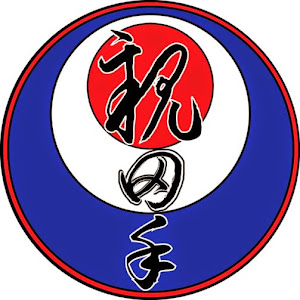Arm-Bar
Application
This is the second “combination” technique that we
teach to our student's. This is a simple, but often
miss-applied technique. This combination teaches the student
the correct manor of application and enactment of it's use.
Although many students have seen the technique (and may very well
have utilized forms of it) this will describe the details of it's
application. In this explanation, we will use the uke's Right arm for
the (following) example of it's application.
Establishing Initial Placement
We will start with the tori holding the uke's Right
wrist, while standing slightly behind, and to the Right of the uke,
using the hand furthest from the uke's body (in this example,
the tori's Right hand). It needs to be mentioned, that when the tori
takes hold of the uke's wrist, the tori should make note of the 2
bones of the uke's forearm (the ulnar, and radius). Using the grip
(using only the thumb and fore-finger) of those two bones, allows for
the tori to rotate the arm and then be conscious of the possible
directions that the uke can/can't bend that arm's elbow
(additionally, the tori will then be aware of which direction
is against the elbow and how the Uke is/isn't able to bend
that elbow). The tori's (closer) Left arm, will lay the side/back of
that wrist, against the lower tricep tendon of the held arm
(by placing it slightly above the elbow, on the dorsal
side of the arm). In addition to the forearm's placement, the elbow
of that same arm (the tori's Leftt arm), will lay against the uke's
back to provide additional feed-back (on any resistive
motions the uke may attempt) and/or to apply any required pressure
there.
Enacting
the “Break-over”
After taking hold of the uke's wrist, the Tori will
begin with motioning that wrist in a circular (in this instance
"counter-clockwise") action. The motion will first move the
uke's arm forward (to the front of the uke), then motion it
towards the opposite side of the uke, and then be "pulled"
back (in a small circular motion). During this circular
action, when the arm begins to be pulled back (towards
the uke's right side), the tori's Left arm, will roll the
uke's tricep muscle tendon towards the front of the uke. As
this begins to cause the uke to lean forward, the tori will lift
the hand being held with their own Right hand, straight up, in
front of the tori. This lifting action, is pivoted off of the tori's
Left forearm(acting as it's pivot point/fulcrum). The motion should
NOT be attempted to only be accomplished by forcing/striking
with the Left arm (in this example)
down/forward (nor ever, from striking the back of the
uke's arm). The pivot point/fulcrum, is only to act for that
purpose, and not utilized in an attempt to initially force the
person down. The raising of the wrist is what will achieve this
purpose. Once the uke has been bent-over (at the waist), then,
the tori's Left forearm can be used to apply additional
pressure to the uke's tricep tendon (to assist in lowering the uke to
the floor).
Take-Down Methods
Once the uke “breaks-over” (and their knee's are
"buckled"), it will be necessary to take them to the
ground. There are several methods to accomplish this. The “first”
(and most obvious) is to apply pressure to the back of the uke's arm
(slightly above the elbow (this is actually applying pressure to the
tendon of the tricep muscle). By varying the angle of that pressure,
it's possible to direct the uke's direction of break down.
If the situation necessitates it (if the Tori is
experiencing difficulties), Tori can additionally knee spear
the uke's thigh, in order to achieve the "knee-buckle"
response (by the uke). Once that is done, the tori can apply pressure
to the upper back of the uke's arm while dragging the uke sideways
(to force them off-balance).
It's also possible to direct the uke upward
(initially) from rolling the uke's tricep muscle towards the uke's
back, and continue circling this pressure around the uke's
arm, until the uke is raising up (to stand on the ball's of
their feet in order to comply with the applied pressure), this should
only be maintained for a (very) short period of time, before
reversing the applied pressure, forcing the uke to the ground.
In extream circumstances, the arm-bar's pressure can
be reversed (using the “held” hand as the fulcrum point
and applying pressure to the upper arm to accomplish a take-down.
This method tends to be dependent upon physical strength, so
should ONLY be attempted for comparison reasons (preferably,
only in a class environment).

